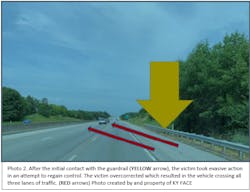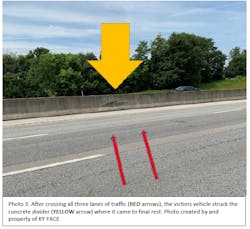Fatality Investigation: IT Consultant Dies Texting While Driving
The Kentucky Fatality Assessment and Control Evaluation (FACE) Program is tasked with investigating fatalities and making recommendations to ensure they do not occur again. This is one of their recent cases.
On Friday, March 1, 2019, a medical IT consultant was driving on a major, six-lane interstate within the city limits of a metropolitan area, en route to a regional airport while on work-related travel out of state. This particular section of the interstate has three total lanes of westbound travel, with the victim traveling in the far-right lane in the moments leading up to the collision, traffic flow was light.
At approximately 6:36 a.m., a police officer on routine patrol witnessed the crash. The police officer stated that as the victim passed his police cruiser on the right side, he observed the driver texting on a mobile phone while operating his 2019 Chevrolet Impala.
At that moment, the victim’s vehicle began exiting the travel portion of the roadway onto the right shoulder. The victim attempted to regain control, but was unable to do so before striking the guardrail on the right shoulder. After contacting the guardrail, the victim attempted to regain control. Unfortunately, the force of the impact in addition to the driver overcorrecting, propelled the vehicle across all three travel lanes and into the concrete median barrier which separates east and west traffic flow. The vehicle struck the barrier on the front driver’s side bumper where it came to final rest. No other vehicles were involved in the collision.
The police officer who witnessed the event was on scene immediately. As the officer approached the vehicle, he noticed the victim partially in the front passenger’s side seat. The officer observed that the driver was not wearing a seatbelt and appeared to be unconscious. The police officer immediately began resuscitation attempts on the victim until paramedics arrived on scene. The victim was transported to a local area hospital where he died ten days later.
The cause of death was traumatic brain injury due to blunt force trauma sustained when the victims head struck the windshield of his vehicle.
RECOMMENDATIONS
1. Implement a texting while driving policy with associated training.
Texting while driving was determined to be a contributing factor that lead to the occurrence of the collision. According to The National Highway Traffic Safety Administration (NHTSA), distracted driving was found to be the contributing factor that lead to 3,157 fatal collisions in 2016; 444 of the total distracted driving fatal collisions were attributed specifically to cell phone usage, which equates to 14% of all distraction-affected crashes2. Texting while driving is one of the most dangerous forms of distracted driving according to The Centers for Disease Control and Prevention. Texting while driving combines all three types of distraction:
- Visual: taking your eyes off of the road;
- Manual: taking your hands off of the wheel; and
- Cognitive: taking your mind off of driving.
Kentucky law prohibits motor vehicle operators from texting while driving. In addition to requiring employees to follow each state’s laws, companies who require employees to travel should consider implementing a policy which prohibits texting while driving. By doing so, the employer sets an expectation and raises awareness surrounding the dangers associated with texting while driving.
2. Mandate the use of seat belts while driving on company time.
The victim was not wearing a seat belt at the time of the collision. Wearing a seat belt can greatly reduce the severity of injuries sustained in a crash. The Centers for Disease Control and Prevention estimates seat belts have saved nearly 250,000 lives from 1975 to 20084. All U.S. states - with the exception of New Hampshire - now mandate the use of seat belts for at least the driver. In addition to requiring employees to abide by each states law, companies who require employees to travel should consider implementing a safety policy mandating the use of seat belts while operating motor vehicles.
3. Implement defensive driver training for employees who are required to travel.
Transportation and logistics companies have utilized defensive driver training for decades to educate drivers on the dangers of the highway and how to recognize hazards and tactics to prevent motor vehicle collisions. OSHA states that 40% of all occupational fatalities are the result of a vehicle-related crash5. Often times, if the primary function of a particular company isn’t focused specifically on transportation, safety training geared toward the safe operation of a vehicle is never addressed. If a company requires an individual to travel to perform his or her job, regardless of the primary function of the company, employees are at risk of being involved in a traffic collision. Employers who require employees to travel should consider implementing a defensive driver program in an attempt to mitigate potential risk associated with the operation of a motor vehicle. In addition to initial training, employers may consider implementing annual refresher training to address complacency.
4. Replace W-beam highway guardrails with cable barriers.
Studies support that the use of cable barriers greatly reduce the severity of injuries sustained during vehicle vs. barrier crashes when compared to W-beam and concrete barriers. According to the Minnesota Department of Transportation, when cable barriers are struck, posts break and cables flex to absorb the kinetic energy and redirect the vehicle along the barrier6. W-beam guardrails are more rigid, which increase the probability of a vehicle being forced back into the travel portion of the roadway leading to overcorrection and a secondary impact. In this case, the initial impact occurred with a W-beam guardrail on the right shoulder of the highway. The force of the initial impact, in addition to the driver overcorrecting, propelled the vehicle across all three travel lanes and into the concrete median barrier which separates east and west traffic flow. The secondary impact with the concrete barrier resulted in the fatal injuries the victim sustained.
The Kentucky highway department should consider installing cable barriers in place of W-beam guardrails in an attempt to reduce the severity of injuries sustained during motor vehicle vs. barrier collisions. In this case, the use of a cable barrier may have absorbed the force of the initial impact and redirected the path of the victim’s vehicle in a straight line preventing it from crossing all three travel lanes and striking the concrete median barrier.
About the Author
DeAnna McIntosh
Safety Specialist
DeAnna McIntosh currently serves as the safety specialist for the Kentucky Fatality Assessment & Control Evaluation (FACE) Program within KIPRC. With a focus on prevention, her reports analyze a variety of contributing factors to each case, and subsequently make prevention recommendations centered on administrative controls, environmental controls, PPE use and existing safety regulations.



